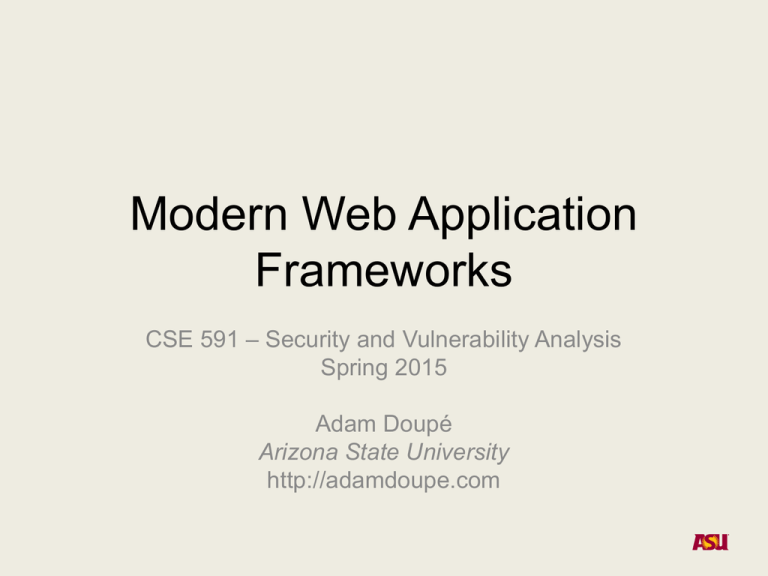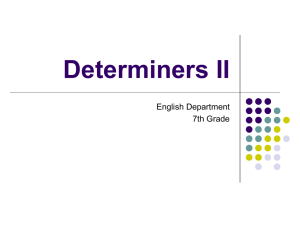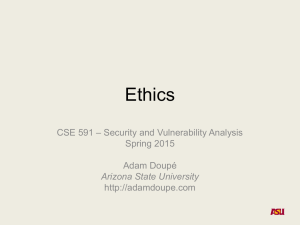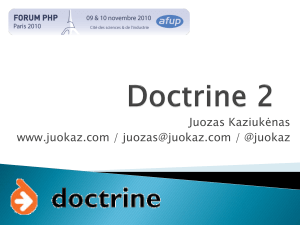Modern Web Application Frameworks
advertisement

Modern Web Application
Frameworks
CSE 591 – Security and Vulnerability Analysis
Spring 2015
Adam Doupé
Arizona State University
http://adamdoupe.com
Overview
• We've seen how the web works
– URIs
– HTTP
– HTML
• We looked at how to dynamically generate
HTML pages
– Server-side code languages
– SQL databases
• We've looked at how to dynamically modify
HTML on the client's machine
– JavaScript
Adam Doupé, Security and Vulnerability Analysis
How to Design a Web Application
• Depends on the framework you use
• CGI applications
– One single file that responds to multiple path
infos (ala Assignment 1 Part 3)
– Multiple files that each respond to their own path
• PHP applications
– Typically many files that correspond 1-1 with a
URL
• ASP applications
– Classic ASP is the same as PHP
Adam Doupé, Security and Vulnerability Analysis
"Natural" PHP code
<?php
session_start();
$_SESSION['username'] = 'admin';
$username_param = $_GET['username'];
if ($username_param != $_SESSION['username'])
{
if ($_SESSION['username'] != 'admin')
{
echo "<h1>Sorry, you can only view your own comments.</h1>";
exit(0);
}
}
$username = $_SESSION['username'];
?>
Adam Doupé, Security and Vulnerability Analysis
"Natural" PHP code
<h1>CS 177 Comments</h1>
<h2>Welcome <?php echo $username; ?>
<p>for debugging purposes you are: <span id='userinfo'><?php echo $_SESSION['loggedin2'];
?></span></p>
<h2>Here are the comments</h2>
<?php
$db = sqlite_open("comments.sqlite");
$query = "select * from comments where username = '" . sqlite_escape_string($username_param) . "';";
$res = sqlite_query($query, $db);
if ($res)
{
while ($entry = sqlite_fetch_array($res, SQLITE_ASSOC))
{
?>
<p><?php echo $entry['comment']; ?>
<br />- <?php htmlspecialchars($username); ?>
</p>
<?php
}
?>
Adam Doupé, Security and Vulnerability Analysis
"Natural" PHP code
<h2>Make your voice heard!</h2>
<form action="add_comment.php?username=<?php echo urlencode($username); ?>"
method="POST">
<textarea name="comment"></textarea> <br>
<input type="submit" value="Submit" />
</form>
<p>
<a href="logout.php">Logout</a>
</p>
<?php
}
else
{
?>
<h1>Error</h1><p> <?php echo htmlspecialchars(sqlite_error_string(sqlite_last_error($db)));
?> </p>
<?php
}
?>
Adam Doupé, Security and Vulnerability Analysis
Spaghetti Code
• How maintainable is this code?
– Imagine all the files are like this
– You want to change how comments are
stored, giving them extra metadata
– You must change every single SQL query in
every PHP files that touches the comments,
as well as all the outputs
• HTML output intermixed with SQL queries
intermixed with PHP code
Adam Doupé, Security and Vulnerability Analysis
Tight Coupling URLs to Scripts
• The natural way to design a web application is to map every
(vaild) URL to a specific script that gets executed
• URLs look like:
–
–
–
–
http://example.com/add_comment.php
http://example.com/view_comments.php
http://example.com/users/view_users.php
http://example.com/admin/secret.php
• And map directly to the following file structure
–
–
–
–
add_comment.php
view_comments.php
users/view_users.php
admin/secret.php
• Is this necessary?
Adam Doupé, Security and Vulnerability Analysis
Adam Doupé, Security and Vulnerability Analysis
Model-View-Controller
• User Interface design framework
– A way to separate the concerts of a GUI
– Originally created in the early '90s
• Popularized by Ruby on Rails to structure
the server-side code of web applications
Adam Doupé, Security and Vulnerability Analysis
Adam Doupé, Security and Vulnerability Analysis
Separation of Concerns
• Model
– Handles all the "business logic" of the application
– Stores the application state
• View
– Responsible for generating a view for the user of the data
from the model
– Usually a simple templating system to display the data
from the model
• Controller
– Responsible for taking input from the user, fetching the
correct data from the model, then calling the correct view
to display the data
– Should be very simple
Adam Doupé, Security and Vulnerability Analysis
Object Relational Mapping
• As a programmer, you don't need to worry
about the database or "SQL" language
• Rails (ActiveRecord)
– user = User.create(name: "David",
occupation: "Code Artist")
– david = User.find_by(name: 'David')
– david.destroy()
– Article.where('id >
10').limit(20).order('id asc')
Adam Doupé, Security and Vulnerability Analysis
Routing
• Define a mapping between URLs and server-side functions
• Also define parameters that get passed to the function from the URL
• Rails example:
class BooksController < ApplicationController
def update
@book = Book.find(params[:id])
if @book.update(book_params)
redirect_to(@book)
else
render "edit"
end
end
end
Adam Doupé, Security and Vulnerability Analysis
Routing
class BooksController < ApplicationController
def index
@books = Book.all
end
end
Adam Doupé, Security and Vulnerability Analysis
Templating
•
Define the view as a simplified language
–
–
Input: well-defined variables or dictionaries
Output: HTML (or JSON or XML, …)
• Ruby on Rails uses ERB:
<h1>Listing Books</h1>
…
<% @books.each do |book| %>
<tr>
<td><%= book.title %></td>
<td><%= book.content %></td>
<td><%= link_to "Show", book %></td>
<td><%= link_to "Edit", edit_book_path(book) %></td>
<td><%= link_to "Remove", book, method: :delete, data: { confirm: "Are you sure?" }
%></td>
</tr>
<% end %>
…
<%= link_to "New book", new_book_path %>
Adam Doupé, Security and Vulnerability Analysis
Modern Web Application
Frameworks
• Many different frameworks for all languages (not a
comprehensive list)
• Ruby
– Ruby on Rails
• Python
– Django
– Flask
• PHP
– CakePHP
• ASP
– ASP.NET MVC
• Java
– Spring MVC
Adam Doupé, Security and Vulnerability Analysis
Homework Submission System
Adam Doupé, Security and Vulnerability Analysis






